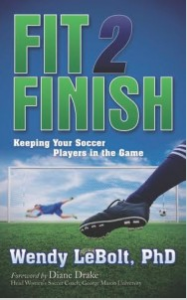Fit2Finish: Design your training with the just-right challenge
 Everyone wants to be fit to play the game, but who has time for extra fitness? And who in his right mind wants to attend “conditioning” sessions? Not me.
Everyone wants to be fit to play the game, but who has time for extra fitness? And who in his right mind wants to attend “conditioning” sessions? Not me.
Fortunately, the game helps us out here in several ways. Because it is demanding, your hard-working players will be training for fitness while they’re working on soccer. Use game play to identify the fitness needed. You can see their lagging fitness from the sidelines when…
- They get shoved off the ball—they need core strength and balance.
- They lose the footrace to the ball—they need sprint speed and quickness.
- Their feet are leaden in the second half—they need endurance conditioning.
- They try the shot with their weaker foot and it dribbles to the keeper—they need targeted strength and coordination in the performance of the skill.
Okay, so now you see it. How to do you train it?
Training Design
Use the FITS format to design training with the just-right challenge. The factors to consider are Frequency, Intensity, and Time (duration) and Specificity.
- Frequency is how often you perform a specified kind of training: daily, 3X/week, weekly, monthly, etc.
- Intensity is the load or demand of the physical training.
- Time is the duration of training, specifically how long a body system is challenged; hours/day, days/week, etc.
- Specificity means you improve only what you train: the energy system, the muscles, the joints, the bones. Choose what you desire to train and design your fitness with that in mind.
Training Load
Then comes the tricky part: the proper training load. Overload without overtraining. That is, the body’s systems need to do more than they’re used to or be “overloaded” in order to get stronger. Just a bit more. And that doesn’t just mean more repetitions. When we subject the body to training demands with change in quantity, quality or type of training we can expect improvement. As a healthy body responds to the increased demand, it adapts and readies to accommodate future demands.
Here is the proper cycle of training adaptation:
Progression (but make haste slowly)
Progression is where we all go wrong. We want to hurry players along toward their potential. But gradual progression using the FITS elements is what they need to sustain their gains and keep improving. Demanding too much too quickly from a body breaks it down. Without adequate time for recovery, adaptation and growth cannot occur. Ignoring recovery is likely to result in injury, so patience in training is essential. The only way to sustain and build on gains is to follow the alternating pattern: challenge/recover/challenge+. The recovery period doesn’t need to be complete rest, but it must offer sufficient recovery to the system that is rebuilding.
How do you know when it’s too much? Since we know this is about individual kids with individual bodies, it gets complicated. The simple answer is: When their form fails, they are doing too much. Back off.
The #1 fitness fallacy, not just for kids but for anyone who wants to stay out of the orthopedists  office is:
office is:
No pain, no gain. (false) While training can be difficult and sometimes uncomfortable, it shouldn’t hurt. Pain is not a natural consequence of exercise or training; it is a signal from the body that should not be ignored. While high intensity training may result in sore muscles and fatigue, if the athletes are in pain, the training is probably excessive. Never require a young athlete in pain to continue. You would never knowingly do this, right? But don’t even imply it.
Especially for boys, don’t belittle a player who may be in pain by calling him weak or wimpy, and monitor this ribbing among players on the team.
Especially for girls, don’t celebrate the player who finished the game on a sprained ankle. Girls will get the idea that this is what you’re looking for and fail to report a minor injury before it gets full blown.
Don’t play through pain, ever.
So, success in training looks like this:
- Identify what each player needs to improve his or her game.
- Include training to address these needs into your practice plan.
- Monitor the demands by watching for form failure.
- Increase challenge regularly but gradually.
- Allow sufficient rest for recovery.
- No pain. No gain has no place in youth sports.
Learn more about this training at the Fit2Finish website
SOCCERWIRE MARKETPLACE
- The St. James FC Virginia 2024-2025 Travel Tryouts
- TSJFCV - Hiring Travel Soccer Coaches
- Hiring: U13-U19 Boys Director
- Coaches Needed
- Train with professional AC Milan coach
- Loudoun Soccer 2024/25 Travel Player Placement Sessions
- Official Elite Summer Soccer Camps with Elite Pro Clubs in Europe
- Official EPL Tickets: ARSENAL, LIVERPOOL, TOTTENHAM & MORE
- Travel to Denmark for Dana Cup Hjørring 2024
- New England Surf Challenge and Showcase 2024











